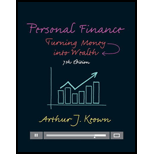
Case summary:
S has just received a raise and now thinking about purchasing a home. Purchasing a home will help him in itemizing his expenses which are now in the 25% tax bracket. He earns $63,000 a year. His expenses include a renter’s insurance premium of $150 per year, $450 monthly lease payment and student loan monthly repayment of $150. His security deposit of 2 months’ rent is earning 8% per annum. He did some research and find out about the cost related to real estate tax, insurance policy cost and maintenance cost. The value of the property will increase because of this; he wants to buy a home. Property prices have been rising at 5% over the last seven years. His concerns are about the closing cost and the down payment amount.
Character in the case:
S.
Adequate information:
S is in 25% tax bracket.
Annual salary is $63,000.
Rent is $900 per month.
Renter’s insurance premium is $150 per year.
Monthly bill of student loan is $150.
Real estate tax rate is $0.91 per $1,000.
Homeowner’s insurance policy cost is $275 per year.
Estimated maintenance cost is $350 per year.
Origination fee is 1% of house value.
Real estate commission is 6% of the purchase price.
Down payment is 20% of house price.
2 month’s security deposit return rate is 8%.
To dtermine:
Four types of housing available for S.
Want to see the full answer?
Check out a sample textbook solution
Chapter 8 Solutions
Personal Finance: Turning Money into Wealth (7th Edition) (Prentice Hall Series in Finance)
- Risk associated with a particular firm’s operating conditions is which of the following risk? a.Financial Risk b.Business Risk c.Liquidity Risk d.Interest Riskarrow_forwardThe discounted cash flow is which of the following approach? a.Forward approach b.Risk approach c.Earnings approach d.Backward approacharrow_forwardexplain The risk that arises due to use of debt by the firm causing variability of return for creditors and shareholders is: a.Liquidity Risk b.Call Risk c.Default Risk d.Financial Riskarrow_forward
- 53. A fixed cash flow in each year for a specified number of years is called as……. a.Annuity b.Compounding c.Reovery Factor d.Discountingarrow_forwardWhat is the full form of "NYSE"? a.Net uield Security Exchnage b.National Stock Exchange c.Net Asset Value d.New York Stock Exchnagearrow_forwardThe method of converting the amount of future cash into an amount of cash and cash equivalents value in present is known as: a.Annuity b.Compounding c.None of these d.Discountingarrow_forward
- The risk that arises due to use of debt by the firm causing variability of return for creditors and shareholders is: a.Liquidity Risk b.Call Risk c.Default Risk d.Financial Riskarrow_forward47. The value of holding period return is always show: a.Greater than 0 b.Less than 0 c.Negative d.Equal to 0arrow_forwardCurrent yield is equal to What? a.Market yield b.Any of these c.Income yield d.Running Yieldarrow_forward
- Explain. The financial activities which are performed regularly are known as: a.Recurring Finance b.None of these c.Non-recurring finance functions d.Both a and barrow_forwardThe risk in terms of variability in security’s total return due to some exogenous factors is known as: a.systematic risk b.Unsystematic risk c.None of these d.Non diversifiable riskarrow_forwardThe Wildcat Oil Company is trying to decide whether to lease or buy a new computer-assisted drilling system for its oil exploration business. Management has decided that it must use the system to stay competitive; it will provide $3 million in annual pretax cost savings. The system costs $8.9 million and will be depreciated straight-line to zero over five years. Wildcat's tax rate is 21 percent, and the firm can borrow at 7 percent. Lambert Leasing Company is willing to lease the equipment to Wildcat. Lambert's policy is to require its lessees to make payments at the start of the year. Suppose it is estimated that the equipment will I have an aftertax residual value of $900,000 at the end of the lease. What is the maximum lease payment acceptable to Wildcat? Note: Do not round intermediate calculations and enter your answer in dollars, not millions of dollars, rounded to 2 decimal places, e.g., 1,234,567.89. Maximum lease paymentarrow_forward
 Essentials Of InvestmentsFinanceISBN:9781260013924Author:Bodie, Zvi, Kane, Alex, MARCUS, Alan J.Publisher:Mcgraw-hill Education,
Essentials Of InvestmentsFinanceISBN:9781260013924Author:Bodie, Zvi, Kane, Alex, MARCUS, Alan J.Publisher:Mcgraw-hill Education,

 Foundations Of FinanceFinanceISBN:9780134897264Author:KEOWN, Arthur J., Martin, John D., PETTY, J. WilliamPublisher:Pearson,
Foundations Of FinanceFinanceISBN:9780134897264Author:KEOWN, Arthur J., Martin, John D., PETTY, J. WilliamPublisher:Pearson, Fundamentals of Financial Management (MindTap Cou...FinanceISBN:9781337395250Author:Eugene F. Brigham, Joel F. HoustonPublisher:Cengage Learning
Fundamentals of Financial Management (MindTap Cou...FinanceISBN:9781337395250Author:Eugene F. Brigham, Joel F. HoustonPublisher:Cengage Learning Corporate Finance (The Mcgraw-hill/Irwin Series i...FinanceISBN:9780077861759Author:Stephen A. Ross Franco Modigliani Professor of Financial Economics Professor, Randolph W Westerfield Robert R. Dockson Deans Chair in Bus. Admin., Jeffrey Jaffe, Bradford D Jordan ProfessorPublisher:McGraw-Hill Education
Corporate Finance (The Mcgraw-hill/Irwin Series i...FinanceISBN:9780077861759Author:Stephen A. Ross Franco Modigliani Professor of Financial Economics Professor, Randolph W Westerfield Robert R. Dockson Deans Chair in Bus. Admin., Jeffrey Jaffe, Bradford D Jordan ProfessorPublisher:McGraw-Hill Education





